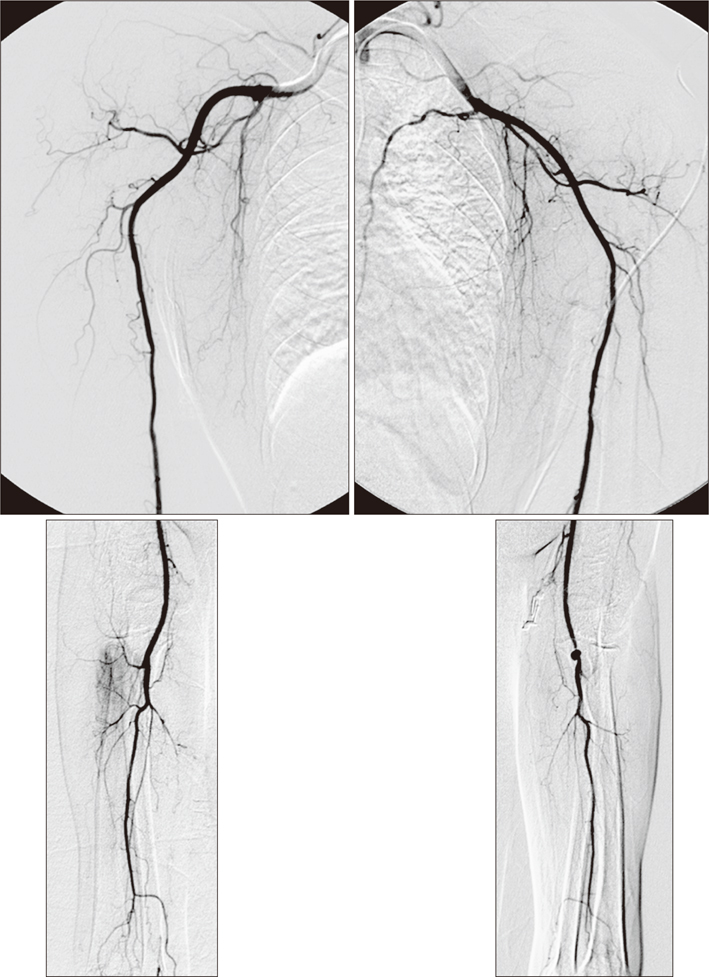Ann Surg Treat Res.
2015 Jun;88(6):349-352. 10.4174/astr.2015.88.6.349.
Alternative prosthetic vascular access creation using subscapular artery as inflow to prevent dialysis access related steal syndrome
- Affiliations
-
- 1Department of Surgery, Soonchunhyang University Seoul Hospital, Soonchunhyang University College of Medicine, Seoul, Korea. ultravascsurg@gmail.com
- KMID: 1800650
- DOI: http://doi.org/10.4174/astr.2015.88.6.349
Abstract
- In patients highly suspected of developing steal syndrome, the subscapular artery may be a good supplier for functional prosthetic arteriovenous access, as well as a good solution for the prevention of steal syndrome. A 51-year-old woman was preparing to have a loop shaped polytetrafluoroethylene (PTFE) graft placed at the left upper extremity. The diameter of subscapular the artery was 3 mm. Arterial calcification was not evident. The diameter of the basilic vein was 6 mm. A 50-cm long 4-7 mm tapered PTFE graft was placed in a loop shape between both skin incisions. The patient was uneventfully discharged at postoperative day 4 without any remaining steal syndrome. The PTFE graft was well-functioning during the follow-up period. The patient did not experience symptoms of steal syndrome any longer.
Keyword
MeSH Terms
Figure
Reference
-
1. Tordoir JH, Dammers R, van der Sande FM. Upper extremity ischemia and hemodialysis vascular access. Eur J Vasc Endovasc Surg. 2004; 27:1–5.2. Beathard GA, Spergel LM. Hand ischemia associated with dialysis vascular access: an individualized access flow-based approach to therapy. Semin Dial. 2013; 26:287–314.3. Song D, Moon C. Surgical treatment, with using distal revascularization intervalligation, for the ischemia that follows creation of hemodialysis access. J Korean Surg Soc. 2008; 74:371–377.4. Mickley V. Steal syndrome: strategies to preserve vascular access and extremity. Nephrol Dial Transplant. 2008; 23:19–24.5. Gradman WS, Pozrikidis C. Analysis of options for mitigating hemodialysis access-related ischemic steal phenomena. Ann Vasc Surg. 2004; 18:59–65.6. Jennings W, Brown R, Blebea J, Taubman K, Messiner R. Prevention of vascular access hand ischemia using the axillary artery as inflow. J Vasc Surg. 2013; 58:1305–1309.7. Valnicek SM, Mosher M, Hopkins JK, Rockwell WB. The subscapular arterial tree as a source of microvascular arterial grafts. Plast Reconstr Surg. 2004; 113:2001–2005.8. Bartlett SP, May JW Jr, Yaremchuk MJ. The latissimus dorsi muscle: a fresh cadaver study of the primary neurovascular pedicle. Plast Reconstr Surg. 1981; 67:631–636.9. Jennings WC, Brown RE, Ruiz C. Primary arteriovenous fistula inflow proximalization for patients at high risk for dialysis access-associated ischemic steal syndrome. J Vasc Surg. 2011; 54:554–558.10. Reifsnyder T, Arnaoutakis GJ. Arterial pressure gradient of upper extremity arteriovenous access steal syndrome: treatment implications. Vasc Endovascular Surg. 2010; 44:650–653.
- Full Text Links
- Actions
-
Cited
- CITED
-
- Close
- Share
- Similar articles
-
- Proximalization of Arterial Inflow for the Treatment of Access-Related Steal Syndrome
- Treatment of Dialysis Access Steal Syndrome with Concomitant Vascular Access Aneurysms
- Surgical Treatment, with Using Distal Revascularization Interval-Ligation, for the Ischemia that Follows Creation of Hemodialysis Access
- Successful Access Rate and Risk Factor of Vascular Access Surgery in Arm for Dialysis
- Brachial-ulnar Artery Bypass for Treating Ischemic Steal Syndrome: Report of A Case



